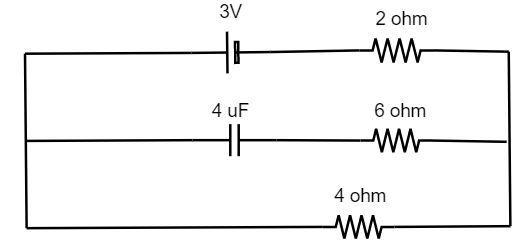
Find the potential drop across $4\,\mu F$ capacitor and $6\,\Omega $ resistor in figure.

(A) $0,\,0$
(B) $0,\,3V$
(C) $0,\,2V$
(D) $2V,\,0$
Answer
216.3k+ views
Hint Find the total current of the given circuit from the rearranged ohm’s law. Again substitute the value of the resistance and the calculated current in it to find the potential drop across the two branches with the capacitor and the $6\,\Omega $ resistor.
Useful formula:
The ohm’s law is given by
$V = IR$
Where $V$ is the potential difference, $I$ is the current and $R$ is the resistance developed in the circuit.
Complete step by step answer
From the given circuit diagram, it is understood that it possesses three branches with the capacitor at the middle branch. Let us use the formula of the ohm’s law,
$V = IR$
Let us find the total current through the circuit, by rearranging the above formula, we get
$I = \dfrac{V}{R}$
Let us consider that the capacitor is fully charged. Since it is fully charged, it will not draw any current from the total current. Hence the current through the branch of the capacitor is zero. Let us substitute this in the above formula, we get
$I = \dfrac{3}{{2 + 4}}$
By performing basic arithmetic operations, we get
$I = \dfrac{1}{2}\,A$
The potential drop across the $6\,\Omega $ resistor is found using the ohm’s law.
$V = IR = 0 \times 6$
$V = 0$
Hence the potential drop across the capacitor circuit is zero.
The potential drop across the $4\,\Omega $ resistor is calculated using the ohm’s law.
$V = \dfrac{1}{2} \times 4$
By simplification of the above step, we get
$V = 2\,V$
Hence the potential drop across the $4\,\Omega $ resistor is calculated as $2$ volt. Since the voltage drop across the parallel circuit is the same, the potential drop in the branch of $4\,\Omega $ resistor must be equal to that of the potential drop across the $4\,\mu F$ capacitor.
Thus the option (D) is correct.
Note: Remember that in the parallel circuit, the total current through the circuit will be equal to the sum of the current through the resistors. The voltage drop across each branch will be equal to the voltage drop across other branches and also the total voltage drop.
Useful formula:
The ohm’s law is given by
$V = IR$
Where $V$ is the potential difference, $I$ is the current and $R$ is the resistance developed in the circuit.
Complete step by step answer
From the given circuit diagram, it is understood that it possesses three branches with the capacitor at the middle branch. Let us use the formula of the ohm’s law,
$V = IR$
Let us find the total current through the circuit, by rearranging the above formula, we get
$I = \dfrac{V}{R}$
Let us consider that the capacitor is fully charged. Since it is fully charged, it will not draw any current from the total current. Hence the current through the branch of the capacitor is zero. Let us substitute this in the above formula, we get
$I = \dfrac{3}{{2 + 4}}$
By performing basic arithmetic operations, we get
$I = \dfrac{1}{2}\,A$
The potential drop across the $6\,\Omega $ resistor is found using the ohm’s law.
$V = IR = 0 \times 6$
$V = 0$
Hence the potential drop across the capacitor circuit is zero.
The potential drop across the $4\,\Omega $ resistor is calculated using the ohm’s law.
$V = \dfrac{1}{2} \times 4$
By simplification of the above step, we get
$V = 2\,V$
Hence the potential drop across the $4\,\Omega $ resistor is calculated as $2$ volt. Since the voltage drop across the parallel circuit is the same, the potential drop in the branch of $4\,\Omega $ resistor must be equal to that of the potential drop across the $4\,\mu F$ capacitor.
Thus the option (D) is correct.
Note: Remember that in the parallel circuit, the total current through the circuit will be equal to the sum of the current through the resistors. The voltage drop across each branch will be equal to the voltage drop across other branches and also the total voltage drop.
Recently Updated Pages
Wheatstone Bridge Explained: Working, Formula & Uses

Young’s Double Slit Experiment Derivation Explained

JEE Atomic Structure and Chemical Bonding important Concepts and Tips

JEE Amino Acids and Peptides Important Concepts and Tips for Exam Preparation

Electricity and Magnetism Explained: Key Concepts & Applications

Chemical Properties of Hydrogen - Important Concepts for JEE Exam Preparation

Trending doubts
JEE Main Correction Window 2026 Session 1 Dates Announced - Edit Form Details, Dates and Link

Atomic Structure: Definition, Models, and Examples

Ideal and Non-Ideal Solutions Explained for Class 12 Chemistry

Degree of Dissociation: Meaning, Formula, Calculation & Uses

Understanding Electromagnetic Waves and Their Importance

Geostationary and Geosynchronous Satellites Explained

Other Pages
MOSFET: Definition, Working Principle, Types & Applications

Inertial and Non-Inertial Frame of Reference Explained

Explain the construction and working of a GeigerMuller class 12 physics JEE_Main

Clemmensen and Wolff Kishner Reductions Explained for JEE & NEET

JEE Main 2023 January 29th Shift 2 Physics Question Paper with Answer Keys and Solutions

Current Loop as a Magnetic Dipole: Concept, Derivation, and Examples




